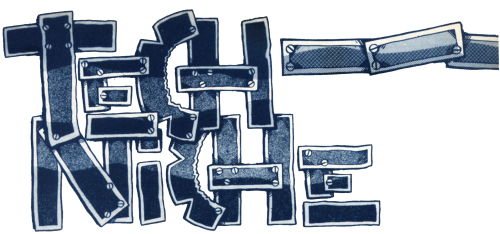
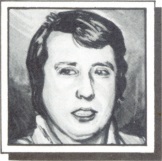
The first Artist program came out in 1985, its CRASH
Smashed sequel in late 1986, but this venerable Softechnics product remains
extremely popular. A +3 version was recently released and IAN CULL decided to
see how it stands up in 1989. Also coming under scrutiny are MGT’s Fixer
and TwoFace, the former promising to solve interface incompatibility problems
for +3/+2A owners.
THE ART OF THE MACHINE
Dated has-been or all-time classic?
BO JANGEBORG developed The Artist II
while working on the sequel to Fairlight, an impressive and Smashed
isometric arcade adventure. Its principal advance over its revolutionary
predecessor was an ST/Amiga-style icon-driven control system currently
supported by Datel, who offer the program, a mouse and interface for
£49.95.
The first thing to say about the new program is that it isn’t really
all that new. The basic program is unchanged from the earlier version, except
that it supports the +3 disk drive and printer interface. Nevertheless, The
Artist II is a very powerful graphics program, offering many functions
useful in creating screen displays.
‘an ST/Amiga-style icon-driven control
system’
One of the most interesting features of Artist II is that it comes complete
with a ‘Page Maker’ program too. This allows screens created with
Artist II to be combined with text written using Softechnics’
word-processing program — The Writer (48K version £14.99,
128K version £17.99). Reviewed in CRASH 31 this was judged very
impressive, and the two together give a form of Desk Top Publishing on the
Spectrum +3 (both mouse compatible). You can even create your own fonts and
fill patterns.
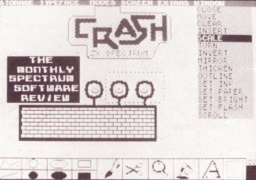
The Artist II: Menus and icons
On loading (which takes about 40 seconds), The Artist II prompts
for the AMX mouse — you can use either an AMX or a Kempston mouse (I was
unable to test this option, however). Unfortunately it is quite easy to
crash The Artist II back into Basic (doing a SAVE to a
write-protected disk, for example. If the LOADER option was used, this will
result in the loss of your masterpiece — so use LOAD
"DISK" from +3 Basic).
As well as driving Artist II by mouse, the keyboard can be used for
all cursor movements — Q/S up/down and I/O left/right. ‘M’
is used to select options or set pixels, and ‘N’ to cancel options
or clear pixels. You can also use a Kempston joystick (which I did for this
review) but Artist II does not support the built-in + 3
‘intelligent’ joystick. I occasionally found that control reverted
to keyboard only, entailing use of the EXTRAS pulldown menu to
re-select Kempston control.
‘Desk Top Publishing on the Spectrum +3’
All Artist II controls are handled using pull-down menus or by
selecting one of the icons at the base of the screen. These include those for
drawing empty or filled shapes — including circles, ellipses and
rectangles. There is also a brush icon, calling up a display of assorted brush
shapes of various sizes, for use when free-hand drawing on the screen. A
scissors icon allows irregular shapes to be cut out of the screen display and
pasted back elsewhere (quite complex to use, but very powerful). The magnifying
glass icon allows sections of the screen to be enlarged for detailed work, and
an A icon allows text entry and a dotted rectangle icon is used to set up
(rectangular) windows.
At the bottom-right of the screen is the current colour and fill pattern
— selecting either of these brings up a menu of colours. The pull-down
menus, across the top of the screen, give access to additional functions
— the STORAGE menu allows
LOADs/SAVEs/CATs and screen dumps to be
carried out. The TYPEFACE menu allows various fonts to be
selected. And the MODES menu allows the way that other operations
will function to be set (eg text can be laid down transparently, or in
colour).
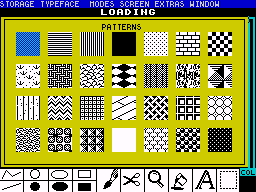
The Artist II: Predefined fill patterns
The SCREEN menu allows the full screen picture to be viewed,
and either the top or bottom section to be displayed for working on (the menus
& icons mean that three lines of the full screen are lost). There is also
an OK option, which stores the current screen — if a mistake
is subsequently made, the undo option will restore the OKed
screen. A pattern option puts a chequerboard pattern over the picture, allowing
attribute alignments to be made more easily.
The last menu option is the WINDOWS one — this allows a
predefined window to be cleared, inverted, scrolled, moved or copied to a new
position on the screen. There are also options to ‘thicken’ or
outline the picture, and to re-scale the picture into a new size and position.
If no window has been defined (or the window has been closed) then any of these
options will operate on the whole screen picture!
LOADing and SAVEing screen files is achieved by
choosing the STORAGE menu, and selecting the appropriate option. A
CATalogue is then displayed, and the SCREEN$ filename
should be typed in — there is no chance to ‘back out’ here,
and specifying a filename which is not a SCREEN$ can cause havoc!
There is also an option to ERASE a file from the disk. One
annoying problem here is that the disk motor continues to run after the disk
option has completed and the Artist II display is restored — to
stop this, do a disk CAT, and wait for the motor to stop before pressing the
space bar.
Alternatively, edit the Basic program, and insert RANDOMIZE USR
14495 into line 2. This may also help other +3 programs which leave the
disk running. The STORAGE menu also offers options to
SAVE/LOAD fill patterns (which can be altered, along
with the character fonts, by choosing options on the EXTRAS menu).
There is also an OTHER option, which seems to do nothing —
left in from the 128K version, and should switch storage to TAPE,
but doesn’t; and a VERIFY option, which simply gives a
‘Nonsense in Basic’ error message.
There are also four print options: large or small colour or grey scale.
The Artist II uses the +3 printer port, but does not use the +3 dump
routines — my printer, an ancient Epson MX80, could not print the
Artist II dumps, even though normal +3 dumps are perfect.
‘A chequerboard pattern makes attribute alignments easier’
Finally, the Page Maker option calls up a new list of options, selected
(confusingly) by pressing a number 1 to 8. From here an A4 sized sheet of paper
can be created bit by bit, using Artist II screen pictures, and
The Writer text (up to 7000 characters). There are functions to cut
out bits of the Artist II screen, and to ‘flow’ text
around the pictures as they are fitted onto the page.
But you always have to be careful of LOADing a new screen
picture when the EXTRAS up option is selected (which allows the
bottom of the picture to be altered). Apparently this confuses the program
— the new picture is loaded in the down-position, but the up option is
still set. This can be sorted, by using the WINDOW SCROLL
function on the whole screen.
Overall, The Artist II is a very powerful graphics package for the
Spectrum +3, but it’s a pity that after all this time the product
wasn’t more polished, with bugs eliminated and proper instructions for
the +3. The Artist II can be purchased on +3 disk for £19.99 from
Softechnics. Alternatively the Datel pack is available from Datel
Electronics.
+3 BUGS AGAIN!
I HAVE HAD some response concerning the printer problems
experienced by Adrian Dixon, regarding his Silver Reed EX32 and +3 paging
subroutine so that the printer strobe signal is normally high, rather than
normally low. My printer (an old Epson MX-80) works perfectly with or without
the pokes, but obviously other printers are more strict. (The Brother 1109 is
another that needs the pokes). The signal is supposed to be high normally, so
it would appear that yet another +3 bug has been unearthed.
Aidan Orton also asks about a replacement chip for his Multiface 3. This is
a specialised chip, Aidan, designed by Romantic Robot. I therefore think that
their repair price of £10.95 is quite reasonable. I cannot imagine what
you were doing to damage it!?
On the subject of Romantic Robot, I have had a number of readers expressing
interest in Genie for the Multiface 3. I have managed to patch my original 48K
version of Genie to run quite well on the +3, but am still working on the 128K
version. It is interesting to note, however, that Romantic Robot were at one
time claiming to be developing Genie +3. (Mr. B. Walton sent me
a copy of a note sent from them in April ’88 assuring him that Genie +3
would be available — I was told much the same when I ordered my Multiface
3). Romantic Robot’s other Multiface program, Lifeguard, does run
successfully on the +3. However, since the Multiface 3 MUST be active in order
to re-load disk-saved games, these programs are less useful than for the other
Spectrums. Perhaps users should have two Multiface 3s fitted.
Various readers are also voicing concern over Spectrum programs that will
not run on the +3. Personally, I have not yet had any trouble (but I have a
backlog of new software which I have not yet had time to load and play). If you
write in with problem programs, CRASH will try compiling a complete list of
them (and manufacturers, if some are worse culprits than others).
EVEN WHILE MGT gear up for releasing the SAM Coupé
(see News) they continue to support the Spectrum with
new products. Two of the most interesting are the Fixer and the TwoFace. While
the former has proved unexpectedly popular, the latter has proved
over-ambitious and is unlikely to be continued in production.
The Fixer is a small circuit board and edge connector designed to allow
owners of the +2A to use the MGT Plus D disk interface. Regular readers will
know the +2A is the black cased version of a +2 with a +3 circuit-board inside.
Since the +3 has a redesigned edge connector many interfaces are incompatible
with it. MGT have subsequently been surprised by the interest in this gadget,
with people hoping it will solve problems with other interfaces as well.
Apparently some high street stores are even talking about stocking it.
‘In 48 Basic the Fixer runs almost every interface I
connected to it’
The Fixer comes in two basic versions, both costing £9.05. A standard
version will connect the +2A to the Plus D, while another version allows the
Opus Discovery disk drive to work with the +2A. Obviously the Fixer only solves
interface problems, and games which crash due to +3 changes in the ROM chips
will be unaffected by the Fixer.
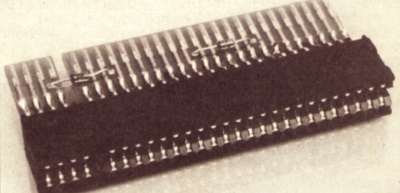
The miraculous Fixer from MGT
To see how well the standard Fixer works I connected to my +3 and gave it a
whirl. In 48 Basic it runs almost every interface I connected to it. The ZX
Interface One and microdrive combination worked perfectly (though trying to
select +3 Basic crashed the Spectrum immediately). The SwiftDisc II interface
(reviewed next month) also worked fine in 48 Basic, but was also usable after
the SPECTRUM command was entered from +3 Basic (ie ‘quasi-48
Basic’). This gives the advantage that the extra memory is still
accessible to machine code. Multiface 1 and 128 both run on the +3 via the
Fixer — in 48 Basic or the quasi mode, with Multiface 3 running too! This
meant that I was able to run Genie on my +3 at last — loading games using
Multiface 3, set up to put the machine into 48 Basic after the load, then using
Multiface 128 to run Genie 128.
‘The TwoFace has proved overambitious and is unlikely to be
continued in production’
Using what the Fixer is designed for, I had similar results. The Plus D
interface worked fine in 48 Basic or quasi-48 Basic, but would not run under +3
Basic. The interface will, curiously, boot from +3 Basic (by typing RUN) but
crashes when booting has finished.
Miles Gordon Technology tell me that the Plus D does work in 128 Basic on
the +2A so the +3 disk system must be causing problems. I don’t know how
much Amstrad would charge for their add-on disk drive, assuming that they bring
it to market, but my money would go on the MGT Plus D or Sixword Swiftdisc
system (both much faster than the +3, and a lot more compatible with existing
utility programs).
The MGT TwoFace is another add-on aimed mainly at Plus D users. It is
reminiscent of the old Currah Micro-slot, in that it allows the Plus D (which
has no expansion connector) to be used on the Spectrum along with other
interfaces. It is more sophisticated however, in that a switch allows either
device to be isolated, and there is also a built-in Kempston joystick interface.
When a Plus D is fitted to the TwoFace, it is mounted vertically, the
combination extending some 6 inches above the desk (with the disk drive cable
emerging from the top) — so anyone who has the Spectrum immediately in
front of the TV may need to raise the screen so it can still be seen. A metal
bracket (supplied with the TwoFace) allows the Plus D to be bolted rigidly to
the TwoFace, so that there is no wobble.
The switch on the TwoFace allows the Plus D (in the top socket) to be active
in the forward or centre position. The rear socket (at least, whatever is
plugged into it) is active in the forward or rear position. The built-in
Kempston joystick interface is always active (unless an internal wire link is
cut, which does not void the guarantee).
Which interfaces work in the rear connector along with the Plus D interface
is a problem to answer. Some devices won’t work because they clash with
the Plus D in such a way that even the disabling switch on the TwoFace cannot
help. Others won’t work because the Spectrum itself cannot drive both
interfaces at one time (some Spectrums have an ‘underpowered’ edge
connector and cannot drive more than one device at once).
Miles Gordon Technology suggest that the best method is to try the required
combination of interfaces and TwoFace (there is a problem-solving flowchart
with the TwoFace documentation). However, they advise that interfaces such as
the ZX Interface One, Swiftdisc and Alphacom printer are unlikely to work.
Interfaces like the Opus Discovery and Beta interface, and even a second Plus
D, should work okay.
‘The Plus D and ZX Interface One seem to be totally
incompatible!’
My own tests largely confirm MGT’s advice. The Plus D and ZX Interface
One seem to be totally incompatible! The Sixword Swiftdisc II seems to run OK,
provided that the Plus D is disabled using the switch. However, the Plus D is
unable to operate usefully. My Alphacom printer and Plus D combination tended
to work OK (most of the time) provided that the switch was correctly moved
before each device was used — rather laborious, and it makes printing
disk catalogues impossible! Trying the Rotronics Watadrive and Plus D gave
rather different results — the Plus D worked fine but the Wafadrive
crashed as soon as it was initialised.
So, the TwoFace will mainly be of use to Opus Discovery or Beta interface
owners wishing to upgrade to a Plus D system (it is a shame that it is not
Interface One compatible to allow upgrades for those users), or for those
Spectrum users simply needing the additional edge connector (for example, the
non-Disciple Multiface 1 & Plus D work fine together via the TwoFace,
provided that the switch is used to keep them separate). The other possible
TwoFace purchaser is a Plus D owner needing a Kempston Joystick interface,
since one is built in. At £29.95, the TwoFace would be an expensive
joystick interface, but gives the option of adding other hardware to the Plus D
at a later date. Remember that if the TwoFace does not work for you, MGT
promise to refund the cost of the Plus D if it is returned undamaged.
TECH MAGS
AFTER LAST month’s coverage of the Miles Gordon Technology Plus D disk
interface, a quick look at the ‘official’ support magazine —
FORMAT. This is a paper-only production, as opposed to the disk-based magazines
reviewed recently. The October ’88 issue contained, amongst other
snippets, a review of the PCG Wordmaster program (to be looked at in detail in
a future Tech Tips), an adventure section in the style of a story about playing
adventure games, some MIDI jargon explained and programming sections on cutting
down the size of Basic programs and adding new machine code commands to Basic
via the Disciple/Plus D interface. The November issue continues the adventure
story and MIDI section, as well as the two programming sections. There is also
a discussion of the SAM Coupé. The Christmas Special has, as well as the
regular sections, User Defined Graphics for use in BASIC games, a screen dump
routine which works in many different sizes, a Catalogue Sort program and a
Basic Battleships game for two — played over the Spectrum network (for
owners of the ZX Interface One or Disciple interface).
FORMAT is received by all members of INDUG, the official MGT users group.
Membership of INDUG costs £10 per year. However, a 3 month trial of the
FORMAT magazine alone costs £3. Full membership of INDUG brings additional
benefits, such as 5% discount on MGT products, utility programs on tape,
etc.
In-depth coverage of your favourite computer’s insides and
appendages will continue next month with, hopefully, a look at the PCG
Wordmaster and a detailed examination of the Sixword Swiftdisc II Upgrade. But
as with all the best columns, the right to change everything is reserved
— just in case something more exciting comes along (like my cheque).
Futile letters urging me to keep my promises, offer advice/information or ask
for help should be sent to Ian Cull, Tech Niche, CRASH.




